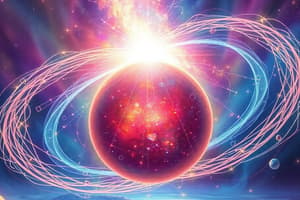Podcast
Questions and Answers
Which of the following describes the particle arrangement in solids?
Which of the following describes the particle arrangement in solids?
- Particles have no fixed arrangement
- Particles are tightly packed in a fixed and regular pattern (correct)
- Particles are far apart and move randomly
- Particles are loosely packed and arranged randomly
Gases have a fixed volume and shape.
Gases have a fixed volume and shape.
False (B)
What is the term for the temperature at which a solid changes into a liquid?
What is the term for the temperature at which a solid changes into a liquid?
melting point
What happens to gas particles as temperature decreases?
What happens to gas particles as temperature decreases?
During __________, a liquid changes into a gas at temperatures below the boiling point.
During __________, a liquid changes into a gas at temperatures below the boiling point.
Increasing the temperature of a solid causes its particles to lose kinetic energy.
Increasing the temperature of a solid causes its particles to lose kinetic energy.
Match the following terms with their definitions:
Match the following terms with their definitions:
What occurs when a liquid reaches its boiling point?
What occurs when a liquid reaches its boiling point?
The process of a solid becoming a liquid is called __________.
The process of a solid becoming a liquid is called __________.
Match the phase changes with their descriptions:
Match the phase changes with their descriptions:
Flashcards are hidden until you start studying
Study Notes
States of Matter
- Solids have a fixed volume and shape, high density, and tightly packed particles in a regular pattern called a lattice.
- Liquids have a fixed volume but take the shape of their container, are generally less dense than solids (except water), and have loosely packed particles that move and slide past each other.
- Gases have no fixed volume or shape, low density, and particles that are far apart and move randomly, quickly in all directions.
Changes of State
- Melting is the process of a solid changing to a liquid, occurring at the melting point (m.p.) and requiring an increase in temperature.
- Freezing is the reverse of melting, occurring at the freezing point, which is the same as the melting point of a pure substance, and requires a decrease in temperature.
- Evaporation is the process of a liquid changing to a gas, occurring at the surface of liquids where high-energy particles escape, and happening over a range of temperatures.
- Boiling is the process of a liquid changing to a gas, occurring at a specific temperature called the boiling point (b.p.) where bubbles of gas form throughout the liquid.
- Condensation is the process of a gas changing to a liquid, taking place over a range of temperatures, and caused by cooling the gas, reducing the kinetic energy of its particles, and causing them to group together.
Heating and Cooling Curves
- A heating curve shows how the temperature of a substance changes as it is heated from a solid to a gas.
- A cooling curve shows how the temperature of a substance changes as it is cooled from a gas to a solid.
- Both curves have plateaus where the temperature remains constant during phase changes (melting/freezing and boiling/condensing) because energy is being used to overcome intermolecular forces instead of increasing kinetic energy.
Pure vs. Impure Substances
- Pure substances are made of only one type of element or compound and have specific, fixed melting and boiling points, resulting in horizontal lines for phase changes on heating/cooling curves.
- Impure substances are composed of more than one type of element/compound and are impure, resulting in lower melting points, higher boiling points, and phase changes that occur over a range of temperatures, represented by sloped lines on heating/cooling curves.
Volume of Gases
- Gases can be compressed by increasing pressure, as the particles are pushed closer together.
- Gases can expand by reducing pressure, as the particles have more space to move.
- Gases expand when heated as the particles gain kinetic energy, move farther apart, and occupy a greater volume.
- Gases contract when cooled as the particles lose kinetic energy, move closer together, and occupy a smaller volume.
Diffusion
- Diffusion is the movement of particles from an area of high concentration to low concentration, down a concentration gradient, until equilibrium is reached.
- This process happens in liquids and gases due to the random motion of particles and the presence of intermolecular spaces.
- Diffusion occurs faster in gases than liquids because gas particles have higher kinetic energy and move faster.
- For the same substance, diffusion is faster at higher temperatures and slower at lower temperatures.
- Diffusion can be demonstrated by the reaction of ammonia (NH3) and hydrogen chloride (HCl) in a tube, where the white smoke of ammonium chloride (NH4Cl) forms closer to the HCl end because ammonia, being lighter, diffuses faster.
Factors Affecting Diffusion Rate
- Lighter particles (lower molecular mass) diffuse faster than heavier particles (higher molecular mass).
- Higher temperatures lead to faster diffusion due to increased kinetic energy.
- Diffusion is a passive process, meaning it requires no external energy input.
Studying That Suits You
Use AI to generate personalized quizzes and flashcards to suit your learning preferences.




